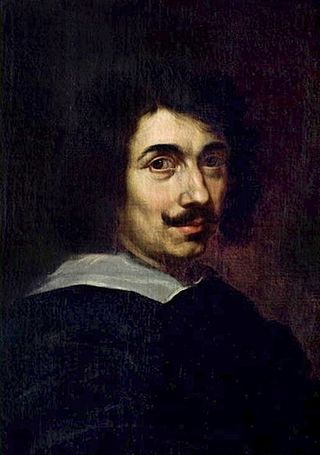
Claude Lorrain was a French painter, draughtsman and etcher of the Baroque era. He spent most of his life in Italy, and is one of the earliest important artists, apart from his contemporaries in Dutch Golden Age painting, to concentrate on landscape painting. His landscapes are usually turned into the more prestigious genre of history paintings by the addition of a few small figures, typically representing a scene from the Bible or classical mythology.

John Constable was an English landscape painter in the Romantic tradition. Born in Suffolk, he is known principally for revolutionising the genre of landscape painting with his pictures of Dedham Vale, the area surrounding his home – now known as "Constable Country" – which he invested with an intensity of affection. "I should paint my own places best", he wrote to his friend John Fisher in 1821, "painting is but another word for feeling".

Richard Wilson was an influential Welsh landscape painter, who worked in Britain and Italy. With George Lambert he is recognised as a pioneer in British art of landscape for its own sake and was described in the Welsh Academy Encyclopedia of Wales as the "most distinguished painter Wales has ever produced and the first to appreciate the aesthetic possibilities of his country". In December 1768 Wilson became one of the founder-members of the Royal Academy. A catalogue raisonné of the artist's work compiled by Paul Spencer-Longhurst is published by the Paul Mellon Centre for Studies in British Art.

Australian art is a broad spectrum of art created in or about Australia, or by Australians overseas, spanning from prehistoric times to the present day. The art forms include, but are not limited to, Aboriginal, Colonial, Landscape, Atelier, and Contemporary art.

Bracciano is a small town in the Italian region of Lazio, 30 kilometres northwest of Rome. The town is famous for its volcanic lake and for a particularly well-preserved medieval castle Castello Orsini-Odescalchi. The lake is widely used for sailing and is popular with tourists; the castle has hosted a number of events, especially weddings of actors and singers.
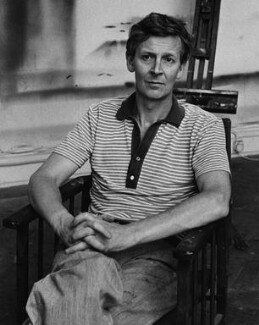
Michael James Andrews was a British painter.
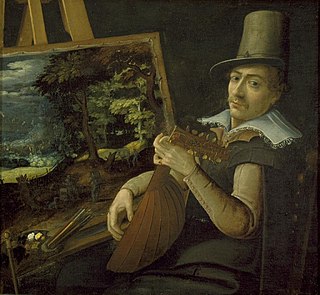
Paul Bril was a Flemish painter and printmaker principally known for his landscapes. He spent most of his active career in Rome. His Italianate landscapes had a major influence on landscape painting in Italy and Northern Europe.

Giovanni Lanfranco was an Italian painter of the Baroque period.

John Glover was an English-born artist. In later life he migrated to Van Diemen’s Land and became a pastoralist during the early colonial period. He has been dubbed "the father of Australian landscape painting."
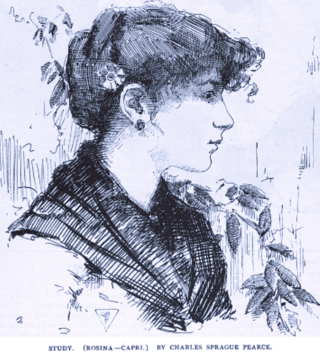
Rosina Ferrara (1861–1934) was an Italian artist's model from the island of Capri, who became the favorite muse of American expatriate artist John Singer Sargent. Captivated by her exotic beauty, a variety of 19th-century artists, including Charles Sprague Pearce, Frank Hyde, and George Randolph Barse, made works of art of her. Ferrara was featured in the 2003 art exhibit "Sargent's Women" at New York City's Adelson Galleries, as well as in the book Sargent's Women published that year.
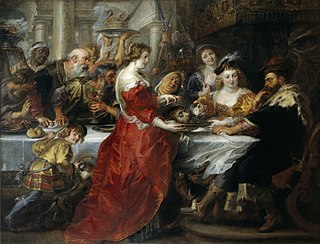
Gaspar Roomer was a Flemish merchant, banker, art patron and art collector who was active in Naples in the 17th century. He played an important role in the support and promotion of Flemish artists who visited and worked in Naples.

Jan Wildens was a Flemish painter and draughtsman specializing in landscapes. His Realist landscapes show an eye for detail and have a serene character. He was a regular collaborator with Rubens and other leading Flemish Baroque painters of his generation in whose compositions he painted the landscapes.

Adriaen or Adriaan van Stalbemt or Adriaen van Stalbempt was a Flemish painter and printmaker who is known for his landscapes with religious, mythological and allegorical scenes. He was also a gifted figure painter who was regularly invited to paint the staffage in compositions of fellow painters.
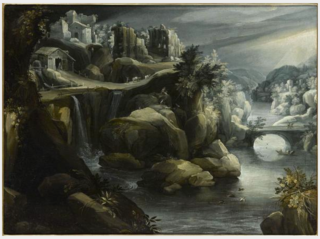
Matthijs Bril or Matthijs Bril the Younger was a Flemish painter and draughtsman of landscapes. He spent most of his active career in Rome where his drawings of ancient Roman sites played an important role in the development of topographical landscape art. He was also a painter of capricci, with typical rustic hills with a few ruins. He died young and his younger brother Paul Bril, who had joined him in Rome, finished his commissions.

Castello Orsini-Odescalchi is a castle in Bracciano, Lazio, Italy. It is located on the southern shore of Lake Bracciano. It was built in the 15th century, and combines the functions of a military defence structure and a civilian residence of the feudal lords of the period, the Orsini and Borgia, both papal families. As one of the largest and best-maintained castles in Italy, it also houses a museum; as a centre of cultural events, the Castello has hosted several high-profile weddings such as those of Tom Cruise/Katie Holmes, Eros Ramazzotti/Michelle Hunziker, and Petra Ecclestone/James Stunt.

Allegory of Fortune, sometimes also named La Fortuna, is an oil painting on canvas featuring the Roman goddess of fortune, Fortuna, that was created c. 1658 or 1659 by the Italian baroque painter Salvator Rosa. The painting caused uproar when first exhibited publicly and almost got the painter jailed and excommunicated. Bearing initials but undated, it measures 200.7 by 133 centimetres. Rosa was known for his landscape paintings, but also worked in the sphere of mythology, witchcraft, portraits, and satire. Since 1978 it has been in the J. Paul Getty Museum in Malibu, California.

Mountainous Landscape with a Bridge and Four Horsemen is an oil painting on panel by the Flemish painter Joos de Momper. Its date of execution is unknown. The painting was once attributed to Paul Bril. It is part of the permanent collection of the Louvre in Paris.

Diana and Callisto is an oil-on-canvas painting by Flemish painter Paul Bril. Probably painted in the early 1620s, it was acquired by the National Gallery, London, in 1924.

Mountainous Landscape with Saint Jerome is an oil on copper painting by Flemish painter Paul Bril. It was painted in 1592, and is currently housed at the Mauritshuis in The Hague. The painting was acquired by the Mauritshuis in March 2013. The painting is signed and dated, and represents the earliest dated cabinet painting by Bril. The painting belongs to the period when Bril associated with Jan Brueghel the Elder in Rome, in the last decade of the 16th century. Bril's work from the 1590s has some affinity to the work by Brueghel from the same period, and in fact the painting was originally considered a Brueghel.
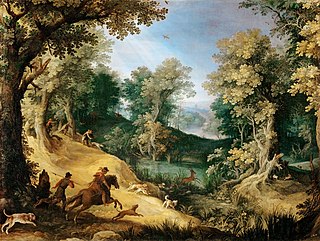
Stag Hunt is an oil on canvas painting by Flemish painter Paul Bril. It was probably painted in the 1590s, and is currently housed at the Louvre in Paris. The painting was once part of the collection of Louis XIV.




















